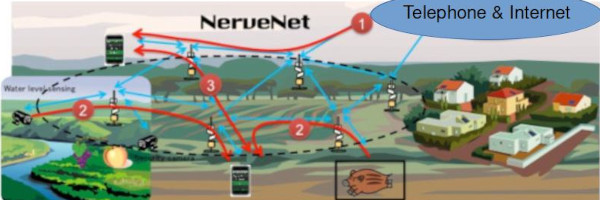NerveNet: Regional Resilient IoT Platform
| NerveNet: Regional Resilient IoT Platform | |
|---|---|

| |
 NerveNet | |
| Team Organizations | National Institute of Information and Communications Technology HIRAKAWA HEWTECH Corporation Nassua Solutions Corporation Uhuru Corporation NEC Solution Innovators Ltd. |
| Team Leaders | Masugi Inoue |
| Participating Municipalities | Shirahama Japan Wakayama Prefecture Japan |
| Status | Launched |
| Document | None |
Description
Project Description Points
- Shirahama is a town on the Pacific coast having a beautiful beach, attracting more than three million tourists. Nearly 10 % are inbound, demanding free Wi-Fi Internet service. It has been promoting “Work in Shirahama”.
- Shirahama, on the other hand, has to prepare for earthquakes and tsunamis because it is officially said the probability of a large, M8-M10 class earthquake occurring within 30 years is approximately 70%.
- The project aims at clarifying the effectiveness of a resilient communication platform called NerveNet, developed by NICT, which provides resilient local communication as well as connectivity to the Internet.
Challenges
- Ensuring communications and information sharing among residents and tourists even if public networks and the Internet become unavailable due to disasters by introducing a resilient communication platform "NerveNet" since sometimes when great disasters happen
- Revitalizing local economy by inviting teleworkers from cities to this town who can work and take vacation at the same time, by introducing IoT Working System on NerveNet to feature telework management
Solutions
NA
Major Requirements
- Achieving a consensus among the project team, local authorities, organizations, and residents on the necessity of doing the pilot test for preparing for disasters and anticipating economic benefits of tourism
- Designing the pilot test such as the configuration of the network, the applications running on it, and the locations of devices to be installed.
- Developing the system (devices and applications), installing it (many devices must be installed outdoor), and testing it.
- Operating it and measuring data
- Achieving a consensus on the benefits of the system
- Sustainable operation of the system by the town
Performance Targets
| Key Performance Indicators (KPIs) | Measurement Methods |
|---|---|
|
|
Standards, Replicability, Scalability, and Sustainability
- NerveNet utilizes standard LAN and IP protocols and systems. Any network appliances with Wi-Fi or LAN interfaces can be connected to it. It provides transparent connection to the Internet. It works as IoT gateway to the IoT Working System on a cloud.
- IoT Working System is scalable and replicable because it works on a cloud and can interwork with other cloud-based middleware and applications.
Cybersecurity and Privacy
NerveNet natively protects users and devices from cyberattacks and leak of privacy information by introducing device access (low-level) management, and instant path for acknowledged communication request between devices including gateways to the Internet.
Impacts
- Economic growth: increase of the number of tourists and workers visiting the town in safety
- New jobs: increase of the number of companies moving into the town because of the resilient town network: 11 companies moved to this town (2 -3 more in a few months) and about 100 new jobs were created as of April 2018
Demonstration/Deployment
The pilot system was installed in May 2015 and has been operated. Since nearly six thousand tourists and residents have used the network for one year after the installation, the town office recognized it to be necessary and allocated the budget to maintain and expand it to their office for SMEs to invite new companies from outside in 2016.
At GCTC Expo in 2019:
Demonstration of main features such as voice/video communication and voice distribution using distributed data synchronization capability is possible with a small set of devices. Other field experiments and use cases can be introduced.